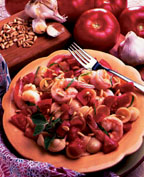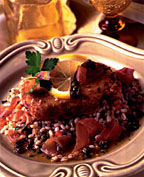Adding olives, capers, extra garlic, anchovies and crushed red pepper to a marinara sauce makes it alla puttanesca, perfect for tossing with penne or slathering on a pizza crust. The fanciful name means “harlot style,” which may refer to the seductive aroma of the sauce or the idea that a woman could cook it quickly, between clients. Fresh Tomato Sauce with Shrimp and Pine Nuts (pictured) is seasoned simply, but admirably, with basil, oregano and garlic. Another way to vary a tomato-based sauce: Create a distinctive seasoning blend, such as crushed basil and oregano leaves, garlic powder, onion powder, fennel seeds and ground black and red pepper.
Of course, many Italian sauces don't contain tomatoes at all. In a pasta sauce made with sautéed broccoli or zucchini, a mixture of warmed olive oil and chicken broth carries the flavors, which include oregano, rosemary, garlic, capers and ground black pepper. The sauce for Pork Scaloppini Perugina (pictured), adapted from a recipe of Manhattan chef Mario Batali, is prepared in a classic Italian manner. After the pork is browned, the pan is deglazed with white wine, which is then simmered with dried sage leaves, garlic, capers and lemon zest.
A Roman restaurateur of the 1920s is credited with creating Fettuccine Alfredo—long egg noodles coated with a rich butter-and-cream sauce, seasoned simply with salt and black or white ground pepper, then topped with a grating cheese such as Romano or Parmigiano-Reggiano. But this is far from the only creamy Italian sauce. For baked pasta dishes, a white sauce (besciamella in Italian) is often used in combination with grated cheese. In one such casserole, thyme adds an herby accent to a creamy mixture of shells, braised radicchio and mushrooms.

Fresh Tomato Sauce with Shrimp and Pine Nuts
2 pounds fully ripened fresh tomatoes2 tablespoons olive oil
1/2 cup diced onion
1 teaspoon dried basil
1/2 teaspoon oregano, crushed
1/2 teaspoon minced garlic
1 pound medium shrimp, shelled and deveined
1/4 cup dry white wine
3/4 teaspoon salt
1/4 teaspoon ground black pepper
1/4 cup toasted pine nuts
Core and chop tomatoes (this should make about 5 cups); set aside for later use. In a large skillet over medium-high heat, heat oil. Add onion, basil, oregano and garlic; then cook and stir until onion is tender, about 5 minutes. Add shrimp, reserved tomatoes, wine, salt and pepper. Cook and stir until all shrimp are pink and tomatoes are heated through, about 2 minutes longer. Remove from heat; stir in pine nuts. If desired, garnish with fresh basil ribbons and serve over hot pasta. Yield: 4 portions.

Pork Scaloppini Perugina
1/4 cup flour1/2 teaspoon salt
1/4 teaspoon ground black pepper
4 boneless pork loin chops, cut 3/4-inch thick (about 4 ounces each)
1 tablespoon olive oil
1 tablespoon capers, rinsed and drained
2 cloves garlic, minced
1-1/2 cups dry white wine
1 tablespoon grated lemon peel
1/2 to 1 teaspoon dried sage leaves
1 teaspoon parsley flakes
4 ounces thinly sliced Prosciutto di Parma, cut in 1/4 x 2-inch strips
Combine flour, salt and pepper on sheet of waxed paper. Lightly dredge pork chops in mixture, shaking off excess. In a large skillet, heat oil over medium-high heat. Add pork chops and cook on both sides until golden, about 8 minutes. Transfer to a plate; set aside. Drain fat from skillet; add capers and garlic. Cook and stir over medium heat for 2 minutes. Add wine, lemon peel, sage leaves and parsley; bring to a boil. Return pork chops to skillet. Cook over high heat until pork is heated through and sauce is reduced by half, about 8 minutes. Stir in Prosciutto di Parma. Spoon sauce over pork on serving platter. Serve with warm barley or lentils, if desired. Yield: 4 portions.
These sauce-based recipes were developed for Prepared Foods by the test kitchen of the American Spice Trade Association. More recipes can be viewed at their website: www.astaspice.org.